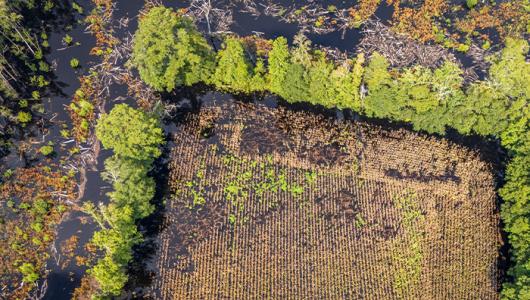When Hurricane Michael struck the central panhandle of Florida last year, 95 percent of 2.8 million acres of forestland was destroyed, according to the Florida Forest Service. Pine timber sustained nearly $772 million in damages, and the cost of reforestation in the most-damaged areas could be as high as $240 million.
Many landowners’ timber was almost ready to harvest, something they were counting on for their retirement. Instead, they are facing the grim prospect of having to clean up the debris and replant those timber stands.
But out of catastrophe can come opportunity.
Like many in the path of the hurricane, Jerry Gaskin from Wewahitchka, Florida, lost the 1,000-acre forest that has been in his family for four generations. He saw the destruction five days after the hurricane buzzed through his pine stands . “My wife and I were driving home from Georgia and saw it off the highway,” he said. The forest was leveled, the trees twisted, torn, broken up, and uprooted. I got out of the car and cried.”
Gaskin’s forest was predominately 35-year-old slash pine that would have been ready for harvest in 10 years. He recovered some of it to sell for 10 cents on the dollar, but Gaskin and co-owner and nephew Frank Grady lost $700,000.
Gaskin is going to replant with help from USDA’s Natural Resources Conservation Service. The agency provides financial and technical assistance to plant longleaf pine through the Environmental Quality Incentives Program. “I love to get out there and look at wildlife. We will get quail, wild turkey, and deer,” he said. “Now my kids can use it and enjoy it like I did,” he said.
Planting Longleaf Pine
Today we know much more about how to effectively plant pines for higher growth rates and better survival. Pine species like longleaf pine, once considered difficult to plant, now have high survival rates. While longleaf takes longer to start growing vertically, it catches up and at harvest time there is little difference in size.
Longleaf also produces more high-value products and, because of its high resin content, weighs more on the scale at the mill. It is also the best species for wildlife and fire tolerant even when burned only one year after planting. Other pine species can’t withstand burning for at least 10 years, allowing understory brush to become too thick for wildlife.
If you are going to replant pines after the hurricane, plant longleaf pine at a lower density. Traditional pine densities were more than 726 trees per acre, but a density of 500 trees per acre will provide better wildlife habitat and allow faster growth. Consider leaving gaps between stands and along the edges as transition zones and leave openings within stands for wildlife.
If you are interested in replanting with longleaf pine, USDA’s Natural Resources Conservation Service and Farm Service Agency have programs that can help finance your reforestation. The Farm Service Agency offers the Emergency Forest Restoration Program (EFRP) that will pay 75 percent of the cost of debris clean up and replanting of pines. Producers will be paid after all the practices have been completed. The Natural Resources Conservation Service offers the Environmental Quality Incentives Program (EQIP) that can pay up to 75 percent of the cost of site preparation and planting longleaf pines. Mechanical site preparation will help clean up some storm debris as part of site preparation but does not pay as much as EFRP. Producers enrolled in EQIP are reimbursed as each practice is completed.
For more information contact your local USDA Service Center.
The Florida Fish and Wildlife Conservation Commission’s Landowner Assistance Program biologists work with NRCS to provide landowners with recommendations and management plans for their forestry and wildlife needs.


